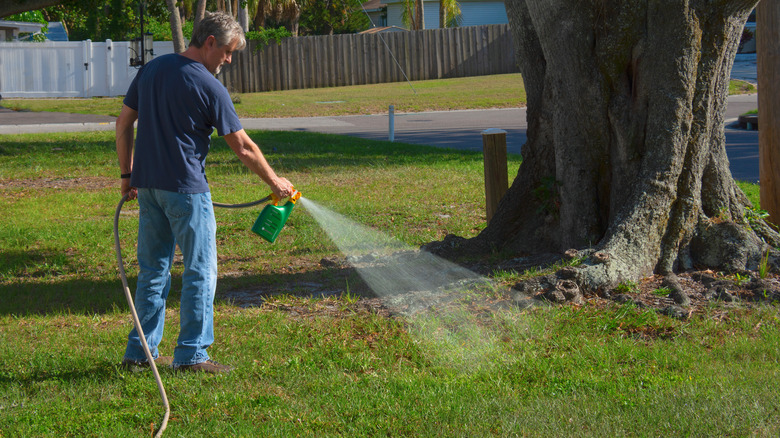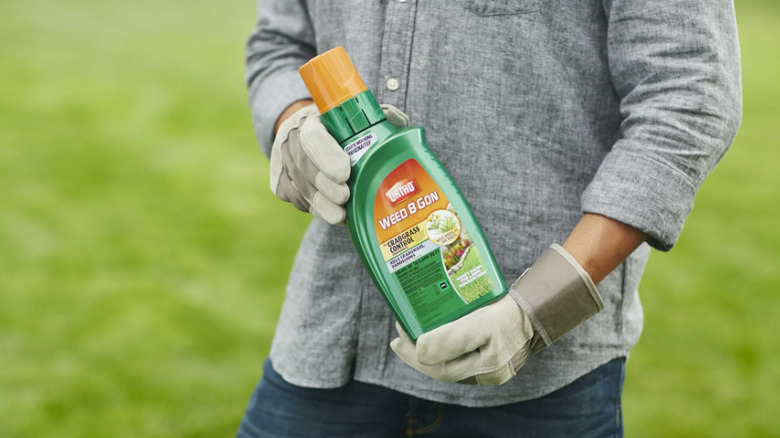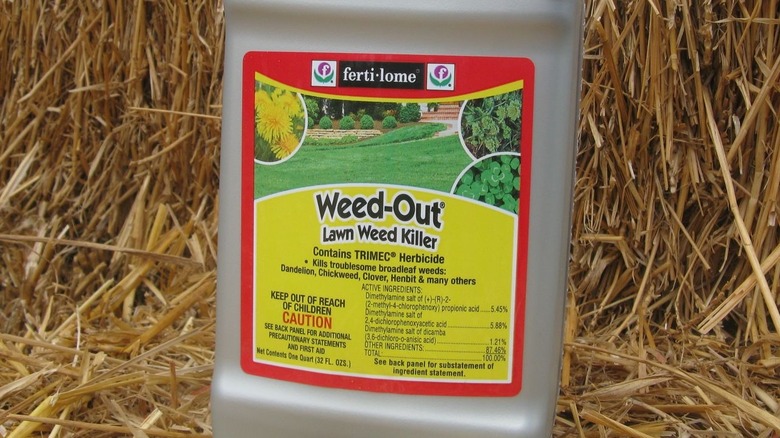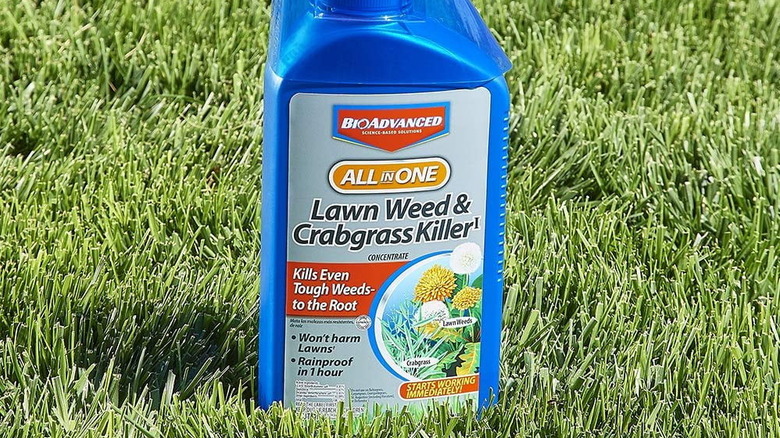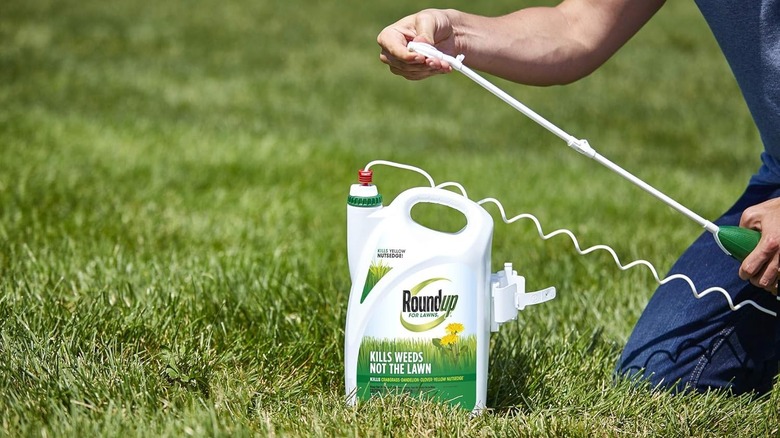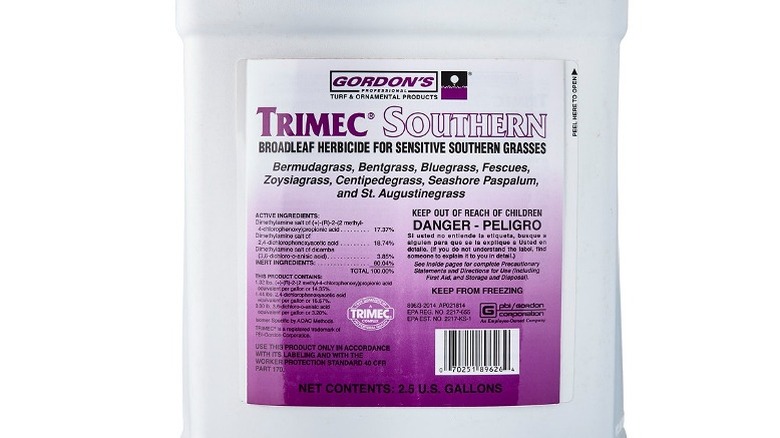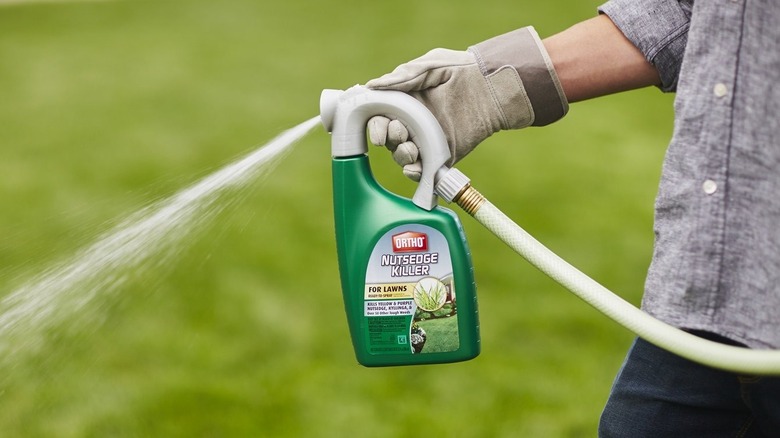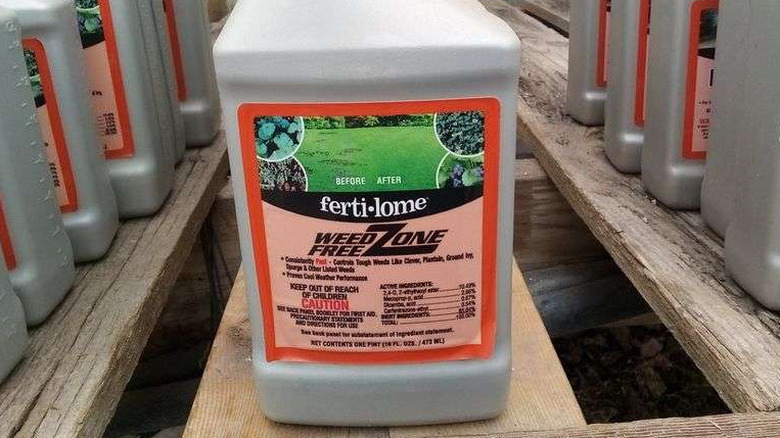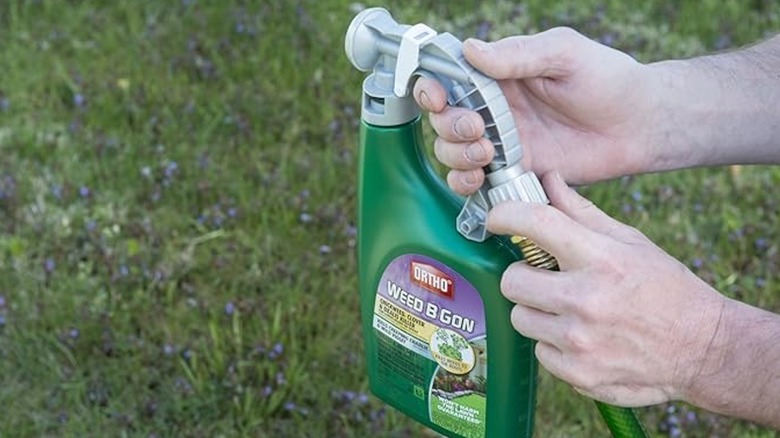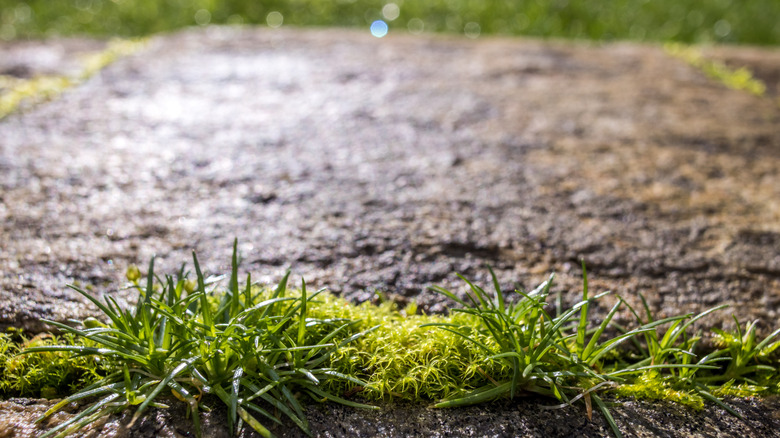The Top-Rated Weed Killers That Won't Kill Your Grass
We may receive a commission on purchases made from links.
Maintaining a pristine green lawn is no easy feat. One slip up in your routine and different types of lawn weeds can immediately sprout up. While some common kitchen ingredients can help control weeds, they're not always enough. For stubborn weeds, especially in larger lawns, a weed killer might be necessary. Store-bought herbicides can save you a lot of time and labor, giving you the upper hand over lawn weeds.
However, not all weed killers are created equal, and choosing the wrong product could also leave you with a scorched lawn. Even if the product is appropriate for your turf, misapplications or drift can significantly damage grass, leaving your lawn looking worse than before (think big bald patches and yellowed or dead grass). Trying multiple weed killer products until you find one that doesn't adversely affect your grass can feel quite hit and miss, leaving a dent in your wallet and cans of half-used herbicides cluttering up your garage shelves.
To make getting rid of weeds in your garden a little easier and ensure your grass doesn't die, we enlisted the advice of several lawn care experts during exclusive interviews. Over the years, they've tested numerous weed-busting products across different turf species and growth conditions, drawing conclusions about their efficacy and potential to damage turfgrass. Below, our experts share their insights on various top-rated weed killers (Ortho and ferti-lome are two brands that stand out) that won't turn your neighboring grass blades into collateral damage.
Ortho Weed B Gon Max is appropriate for treating small weed patches in the lawn
When you're looking to treat stray weeds popping up across your lawn, Ortho Weed B Gon Max Plus Crabgrass Control is a post-emergent herbicide that carries little risk of hurting your lawn. Wild onion, wild garlic, sandburs, bindweed, crabgrass, dandelions, plantains, black medic, clover, and most other major broadleaf or lawn weeds stand no chance against it. During an exclusive interview with House Digest, Scott McLeod, owner of McLeod Landscaping Inc., recommended this particular product, saying, "For spot treatment of individual weeds in lawns, I prefer Ortho Weed-B-Gon Max." Provided you apply it according to the label, it should target weeds selectively without detriment to your turf. "It's designed to only impact targeted weeds, so I've never seen damage to lawns when following the instructions," assures McLeod.
What makes the Ortho weed-killing concoction so effective? "Its formula with 2,4-D and Quinclorac eliminates weeds down to the roots but won't hurt surrounding grass," he explains. This selective herbicide effectively eliminates most pernicious weeds within 2-4 weeks and can even brave the rains if applied an hour before. However, Ortho does recommend you wait at least 12 hours to water your lawn. Ortho Weed B Gon Max can be used on St. Augustinegrass, centipedegrass, fescue, Kentucky bluegrass, ryegrass, zoysiagrass, perennial ryegrass, bahiagrass, and buffalograss. It's also suitable for Bermuda grass, but do not apply Ortho Weed B-Gon (or any other weed killer) when the mercury has soared past 85 degrees Fahrenheit. For other grass species, do not apply in temperatures above 90 degrees Fahrenheit. Ortho advises that its product should not be used on bentgrass, carpetgrass, or the Floratram variety of St. Augustinegrass, as well as lipia or dichondra planted as lawn alternatives.
Ferti-lome Weed Out Lawn Weed Killer permanently puts down pernicious lawn weeds
Another post-emergence herbicide that our experts recommend is ferti-lome Weed-Out Lawn Weed Killer. Sal Musto, owner of SalCorp Landscaping & Construction, and who has 20 years' worth of lawn care experience, tells House Digest, "One of my favorite selective herbicides is ferti-lome Weed-Out." He has been using it for decades to successfully eliminate dandelions and clover on customers' properties. Ferti-lome's weed killer can also remove spurge weed from your yard, along with other broadleaf weeds like invasive ground ivy, chickweed, henbit, dollarweed, poison ivy, and mullein — as stated on its label. For best results, apply it during the target weed's active growth season, which is usually spring. You may also spray it during autumn to neutralize any late germinating weeds.
Ferti-lome Weed-Out Lawn Weed Killer includes various active ingredients, such as 2,4-D, dicamba, and mecoprop. Combined, these behave as synthetic auxins or hormones that interfere with weeds' growth, yielding significant results while leaving turfgrass unhurt. To improve your results, consider blending this herbicide with a surfactant. Avoid it on St. Augustinegrass 'Floratam' in southern states. It also doesn't work well on carpetgrass or still-establishing turf. Ensure temperatures are between 65 and 85 degrees Fahrenheit before application.
BioAdvanced All-in-One Lawn Weed & Crabgrass Killer purges weeds with minimal turf damage
Bob Berriz, owner of Berriz Design Build, highly recommends using BioAdvanced (previously Bayer) All-in-One Lawn Weed & Crabgrass Killer. "I've used it successfully for decades to eliminate dandelions, plantains, and crabgrass in clients' lawns without any damage," he states. Kate Hill, director and founder at Kate Hill Flowers, seconds his pick. "I've seen it work wonders in various settings, from expansive lawns to more intimate garden spaces. The key lies in its tailored formula, which targets over 200 types of weeds, including dandelions and clovers, without harming the grass." The product promises even to banish crabgrass, henbit, creeping Charlie, thistle, and wild mustard.
This post-emergent herbicide works best on young weeds that are actively growing between spring and fall. It's easy to apply the product since it simply hooks to your hose and can be sprayed that way. Berriz explains that the formula "uses Trimec, a selective herbicide that targets weeds but doesn't harm most lawn grasses." Trimec is a three-way mixture of 2,4-D, dicamba, and quinclorac. However, owing to its formulation (mainly 2,4-D), this product faces size restrictions in Texas, where you can't buy bottles of concentrated solution bigger than 32 oz. It also isn't available for sale in New York and Hawaii. Note that dicamba becomes easily volatile in warm temperatures, which can cause herbicide drift. So this weed-killing product can be tricky to apply close to landscape beds, especially those that contain broadleaf groundcovers, like dichondra. To reduce the risk of herbicide drift, do not spray in hot weather.
Roundup for Lawns provides season-long control of weeds
Don't automatically classify Roundup for Lawns as one of the worst weed control products for your turf, as not all Roundup products carry glyphosate — the hotly-debated, carcinogenic chemical that's become synonymous with the brand name. Roundup for Lawns doesn't contain glyphosate, unlike regular Roundup. Similar to ferti-lome Weed-Out, it contains a combination of synthetic auxins, like dicamba, quinclorac, MCPA, and sulfentrazone, which individually target broadleaf weeds, crabgrass, and sedges. Joe Gerrior, owner of Gerrior Masonry & Landscape Construction Corp. shares that if used correctly, Roundup for Lawns efficiently kills weeds without impacting ornamental plants or turfgrass. "I've used it for years to eliminate dandelions and clover in customers' lawns between mowing without damaging the grass. By carefully spraying only weed leaves and avoiding over-application, Roundup for Lawns removes weeds without the damaging effects of total herbicides."
That being said, Roundup for Lawns raises confusion because it has a southern version, too. It's distinct from the northern version because it contains Penoxsulam and 2,4-D, is suitable for certain southern grasses, including St. Augustinegrass 'Floratam,' and only targets 93 weeds. In contrast, the regular Roundup for Lawns banishes over 253 weeds and is appropriate for northern grasses, such as Kentucky bluegrass, tall fescue species, and perennial ryegrass, among others mentioned on the label. Both products contain dicamba, which can volatize in high temperatures, turning into a gas that can drift, hover, and settle where you don't want it. For best results, don't apply it in very hot weather, spot treat only, and water your lawn roughly 8 hours before and after application, according to the product's instructions, if conditions are dry.
Trimec Southern takes out a variety of broadleaf weeds in southern lawns
Lisa Wark of Champion Distinctive Landscaping Design and Care makes a strong case for Trimec Southern in her exclusive interview with House Digest. It's a selective post-emergent herbicide geared toward treating weeds in sensitive warm-season grasses, such as St. Augustinegrass, bentgrass, and centipedegrass. "One of my favorite selective herbicides is Trimec Southern," states Wark. "I've used Trimec Southern for years with great success to eliminate weeds in Bermuda grass and zoysia lawns without any damage. The unique formula is designed for the climate and weeds in the Southern U.S., so it's very effective."
This weed killer chokes over 90 pernicious weeds, including chickweed, henbit, and dandelions. Wark explains, "It contains 2,4-D, MCPP, and dicamba which target a wide range of broadleaf weeds commonly found in Southern lawns like clover, spurge, and chickweed." In fact, so clever is its composition that Trimec Southern can suitably be used in northern turf to get rid of clover in your lawn. It holds relatively lower concentrations of 2,4-D, an active ingredient that can trigger lawn injury in hotter climates. Thanks to this, you can use Trimec Southern to play it extra safe in the North, reducing the risk of damage to your lawn when targeting clover. To further limit instances of herbicidal injury on your turf, cease application during stressful environmental conditions, especially drought. Avoid using it on grasses still waking up from winter dormancy or when temperatures soar past 90 degrees Fahrenheit. Seashore paspalum, St. Augustinegrass, and centipedegrass are the most sensitive to Trimec Southern, so be extra careful not to overapply on these turf species.
Ortho Nutsedge Killer is a go-to for decimating tough weeds in lawns
Ever experienced a time when it poured with rain and yellow nutsedge took over your turf? Well, you can put this pesky plant to bed and shortcut your weed eradication journey by applying Ortho Nutsedge Killer. Wark names this powerful product as her top choice for spot treatments, applauding the fact that it effectively eliminates tough-to-remove nutsedge without causing damage. "I once had a customer with a severe nutsedge infestation that we were able to eradicate in a single application without hurting his zoysia lawn. The selective formula specifically targets nutsedge for outstanding control," shares Wark. Ortho promises its product will wilt weeds in under two days and fully decimate nutsedge in three weeks.
One of the key components in Ortho Nutsedge Killer is sulfentrazone, a fairly new herbicide ingredient that targets nutsedge tubers, effectively killing any burgeoning or nearly-established sedge plants. Aim to catch the weeds in action before they've hit their fifth-leaf stage by targeting them when they still measure under 3 inches in height. After this point, the formula won't have the opportunity to translocate to the sedge's roots and will only kill the above-ground foliage. Besides targeting nutsedge, Ortho Nutsedge Killer also eliminates plenty of other perennial and biennial weeds, such as kyllinga, purslane, pigweed, broadleaf plantain, and spurge. Note that its results can be hit or miss for purple nutsedge and the formula is sensitive to heat, relegating its use to early summer or late spring.
Ferti-lome Weed Free Zone does what it promises sans turf damage
Another post-emergent herbicide that deserves a spot in your weed control arsenal is ferti-lome Weed Free Zone. It promises effective results against ground ivy, poison ivy, oxalis, purslane, Virginia buttonweed, and shepherd's purse — some of the vilest weeds ever to colonize turfgrasses and garden beds. Immediately after the first application, the weeds slump, turning lifeless in under two weeks. This also means you can reseed your lawn after 14 days, wherever necessary. This ferti-lome product is another top pick for Wark, who says, "I used it when overhauling a commercial property's grounds, removing clover and dandelions without harming the existing turf." She continues, "Its amine salt of 2,4-D targets broadleaves but spares most grass types." Besides 2,4-D, it also includes other active ingredients like mecoprop, dicamba, and carfentrazone that zaps broadleaf weeds but leaves grass blades alone.
Ferti-lome Weed Free Zone can be sprayed on a range of warm- and cool-season grasses, including zoysiagrass, bahiagrass, Kentucky bluegrass, hybrid Bermuda grass, and St. Augustine grass (except 'Floratam' and 'Bitterblue' varieties). Ferti-lome directs not to apply the herbicide when temperatures exceed 90 degrees Fahrenheit. However, even if you stick to this guideline, St. Augustine and hybrid Bermuda grass may show transitory signs of yellowing and discoloration. It's also best not to apply it to St. Augustine grass during spring green-ups. While spring through fall applications are allowed, weeds may not respond if they're already drought-stressed, and summer treatments pose the most risk to your turf. Drought-stressed grass is also more vulnerable to burning and injury.
Ortho Weed B Gon Chickweed, Clover & Oxalis Killer controls broadleaf weeds
Rounding off the list of weed killers that won't also decimate your grass is another top recommendation from Hill: Ortho Weed B Gon Chickweed, Clover & Oxalis Killer for Lawns. One of its primary active ingredients is triclopyr, a chemical herbicide that combats most broadleaf and woody weeds. Triclopyr behaves as a systemic growth regulator (auxin), coaxing weed species to produce abnormal growth. Eventually, the roots give out. The signs become apparent after two weeks, with complete eradication happening in week three. "Ortho Weed B Gon Chickweed, Clover & Oxalis Killer hasn't failed expectations," Hill notes, adding "I advised its use in a nature reserve that needs to maintain biodiversity without jeopardizing the main grass. It performed impressively with minimal environmental impact."
She values this weed killer's pointed approach and says, "Its targeted action is perfect for more stubborn weeds that resist typical treatments." Ground ivy, wild violets, and speedwell feature among the listed targets. However, Ortho Weed B Gon Chickweed, Clover & Oxalis Killer doesn't work on grassy weeds. Its effects are also limited when the mercury dips below 60 degrees Fahrenheit or soars past 90 degrees Fahrenheit and weeds go dormant. The product is best applied on dry days, as it's not rain-resistant and can require over six hours to be absorbed. Avoid applying it to recently mowed grass (or mowing within a couple of days of application), as this limits the surface area and can inhibit and diminish the weed killer's action. Although the nozzle is easy to use, spray it carefully around your ornamental plants and vegetables, or you'll accidentally harm them.
Horticultural vinegar can safely fix the weedy problem in your surrounding hardscaping
The above weed killers will rid your lawn of invaders, but what about any pathways or other hardscapes in and around your lawn? If you've got weeds popping up in a stone pathway traversing your turf — or a patio area bordering it — here's a handy recommendation from Gerrior: Horticultural vinegar. Unlike household vinegar that contains 5% acetic acid, horticultural vinegar holds a higher concentration, making it a valuable tool for fighting weeds. Gerrier says, "For natural stone walkways and patios, I use horticultural vinegar, with 5-10% acidity, to burn out weeds sprouting between pavers or bricks. The acid dehydrates weed leaves on contact but does not leach into or damage the stone." The results are pretty immediate, though reapplications might be necessary. "After application, the dead weeds pull out easily by roots without the use of harsh chemicals," adds Gerrior.
Besides being effective, horticultural vinegar is also relatively cheap, typically costing less than most herbicide products. For instance, you can buy a gallon of 30% concentrated vinegar on Amazon for $23.99. For weed control and other household purposes, you can dilute this concentration down, making it stretch even further. Study results from the USDA Agricultural Research Service showed that concentrations of 10-20% are typically the most effective (having eradication rates of 85-100%), but a 2018 study in the Journal of Agricultural Science found that 5% vinegar was highly effective on cutleaf evening primrose. Crabgrass, plantains, and ground ivy respond better compared to quackgrass. Word of warning: Before you apply or work with horticultural vinegar in any way, make sure you wear gloves and eye protection (as it can cause permanent eye damage) and clothing that will shield your skin from contact.
